
Visit Shrines
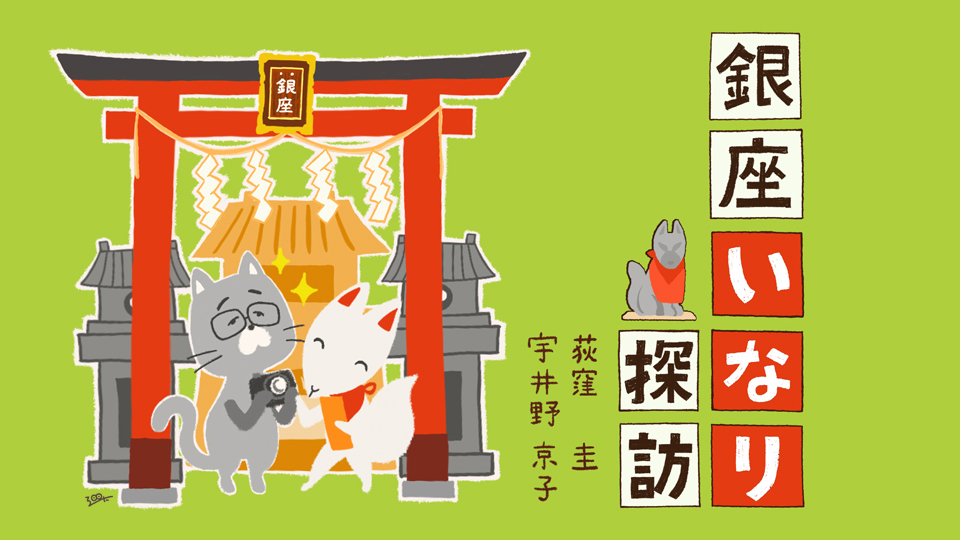
Visit Ginza’s Inari Shrines Vol. 5 Azuma Inari
2021.02.01
We often count our calendar years using “Gengo.” Recently, we entered the Reiwa period. A Gengo can be longer or shorter than others, so some people experience several eras. Now that we are in the Reiwa period, people who know the Showa period have lived through three eras – Showa, Heisei and Reiwa.
This time let us feel the Showa air in the middle of Ginza in Reiwa. Let us start at the Miharabashi Intersection, located east of the Ginza 4-chome Intersection on Harumi Dori.

- Uino
- Ogikubo-san, look! They are filming something there.
- Ogikubo
- That must be the new Miharabashi. It has a modern look now.
- Uino
- Miharabashi was one those places where we could still strongly feel the atmosphere of the Showa period. The Showa period was a time when…
- Ogikubo
- It was the Showa period until only recently. Miharabashi was a bridge built over Sanjikken-bori from the Edo to Showa period.
- Uino
- Isn’t that the moat where the deity of Asahi Inari Shrine appeared?
- Ogikubo
- Yes. It was buried after WWII, using the debris from the aftermath of the war. I happen to have maps from both before and after the Sanjikken-bori was buried – Kyobashi-ku in 1931 (Showa 16) and Chuo-ku in 1953 (Showa 28).
- Uino
- How impressive. Why do you have them in your possession?
- Ogikubo
- They just happened to be a part of my collection of old maps. Let us compare the maps before and after the war. I think that if we check Mitsukoshi Department Store and Matsuzakaya Department Store (currently, GINZA SIX) and the Kabukiza Theatre, we can have an idea of the overall location.
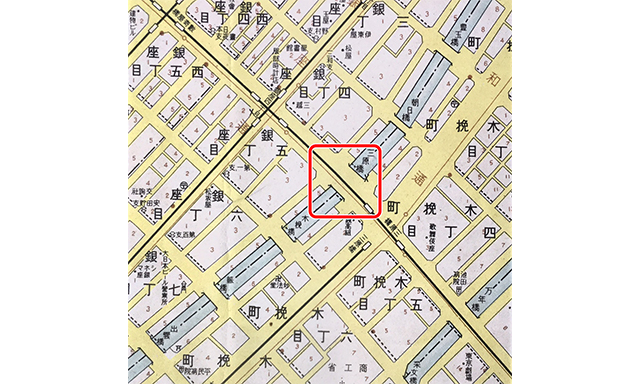
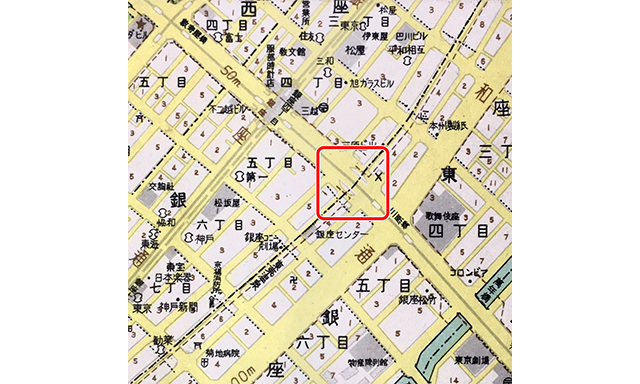
- Uino
- The disappearance of a is quite a change for a townscape.
- Ogikubo
- That is when a small underground mall was built under the bridge. It continued to be used from the period after the war, through the high-growth period and the bubble economy. There was a movie theatre in the underground mall, too. I was so surprised when I first saw it. It was amazing that you could just walk down and find yourself underground. And once you were underground, everything just looked like it had come from the Showa period. Well, to be precise, it wasn’t underground – it was under the bridge.
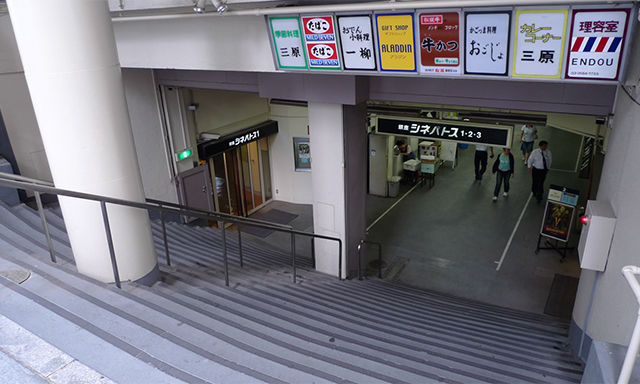
- Uino
- That brings back memories. When was this picture taken?
- Ogikubo
- It was taken in 2008, thirteen years ago. The movie theater under the street was quite sensational. Have you ever been there?
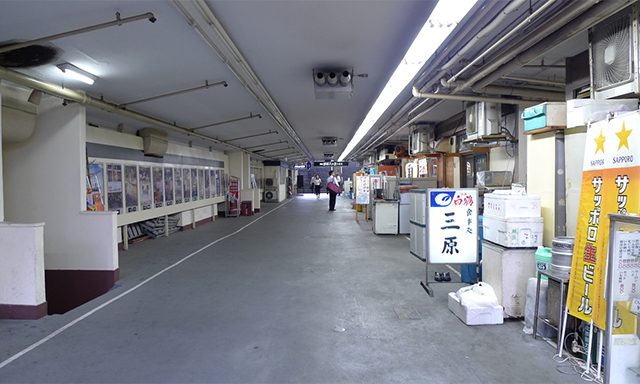
- Uino
- I had always wanted make a visit when I had enough time to enjoy it in full, but unfortunately never had a chance to go.
- Ogikubo
- Same here. It was a place that I had always wanted to visit, but it was reclaimed after they found issues with its quake resistance. Now they have made a nice park around where the entrance used to be.
- Uino
- A park is indeed a valuable spot that can be enjoyed by many people, but I also find value in facilities like this that can never be built again.
- Ogikubo
- So, now that we have met at Miharabashi, which Inari Shrine are we headed for?
- Uino
- Today, our destination is Azuma Inari Shrine, which has close ties with Miharabashi.
- Ogikubo
- I know that one. I found it by chance when I was strolling around Ginza with my camera. If I remember correctly, it was located on a narrow street going down the street running by Miharabashi (Ginza Mihara Dori).
- Uino
- That is right. That narrow street is called Mihara Koji.
- Ogikubo
- Here it is. The retro-inspired letters are nice too. I also like how both old and new restaurants are lined up on this small street wide enough only for people to pass through.
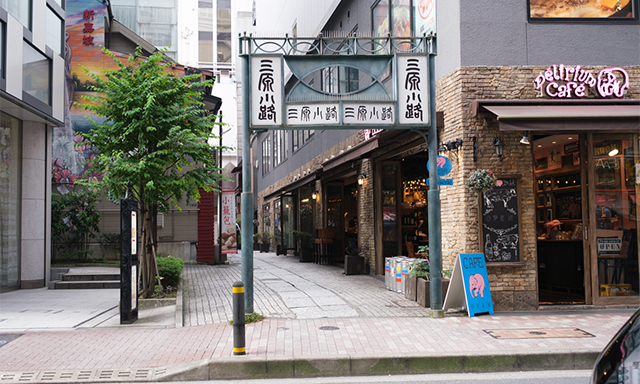
- Uino
- My thoughts exactly! It is one of those picturesque places that I would like to stroll down in my favorite kimono. When I first visited the shrine, I felt like I was standing in a movie set, but time has given it “vintage” as we would say for a piece of antique. It feels as though we travelled in time to come here.
- Ogikubo
- Azuma Inari Shrine is located down this street, right? It looks like it has been cleaned up since my last visit here. It used to look more like a movie set. Oh, here we are.
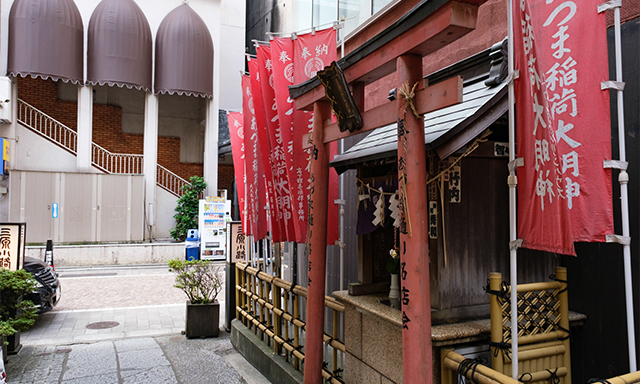
- Uino
- After World War II, fires broke out one after the other in this area and when people sought the reason, they discovered that the area had originally been home to an Inari Shrine. Hence, the district received an apportioned deity from the Fushimi Inari Shrine in Kyoto.
- Ogikubo
- Then it was an Inari deity for fire prevention. Inari deities for prosperity and fire prevention sound like the perfect match for Ginza.
- Uino
- I guess many things occurred during the post-war restoration, since people running businesses in the area all joined forces to build a local shrine.
- Ogikubo
- I happened to have a map of downtown Ginza from around 1965 (Showa 40). Shall we have a look? Ginza Core was constructed in 1971 (Showa 46), so this was just a little before that>
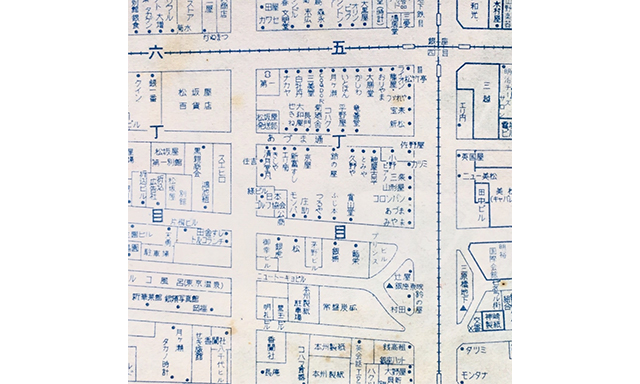
- Uino
- There were many small stores where Ginza Core stands now. The owners of these different businesses must have come together to enshrine the apportioned deity.
- Ogikubo
- Kikunoya still has a shop in Ginza Core. This map tells how Ginza looked in the post-war period just before an increasing number of modern buildings came to be built on Chuo-dori. It is quite fascinating to imagine that the Inari deity was enshrined amid this process of modernization.
- Uino
- The aim of “Visiting Inari Shrines” is exploring a neighborhood to feel old ways of life that have been passed down from the past. The Azuma Inari Shrine really lets me feel that connection, especially because it experienced a milestone during the Showa period, which I myself am very familiar with.
- Ogikubo
- That is true. The Edo period can only be imagined, but the Showa period is a time that we have witnessed. People born during the Heisei period can still hear firsthand stories of the high-growth period from real people.
- Uino
- I am curious to know what the original shrine looked like. The Azuma Inari deity seems like a real tutelary deity to me.
- Ogikubo
- Yes. I saw many people visiting the shrine as they passed by.
- Uino
- I have heard that some people continue to bring offerings of rice and salt on the first day of each month even after retirement.
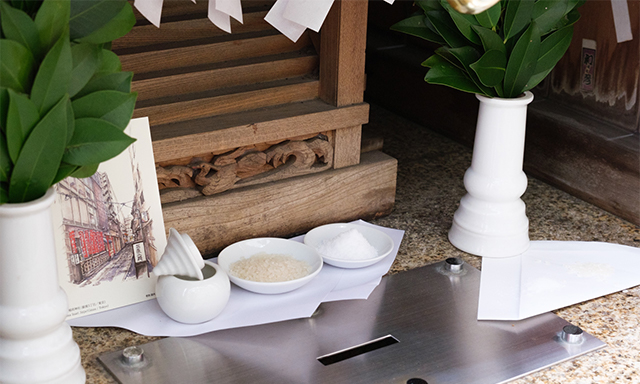
- Uino
- I also wanted to show you these unique flags. Did you realize that each flag is resist-dyed separately for each dedicator?
- Ogikubo
- Resist-dyed?
- Uino
- Yes. Usually, the dedicators’ names are handwritten on flags with only the shrine’s name resist-dyed. It is the same as printing. When you think about making separate prints for each dedicator…
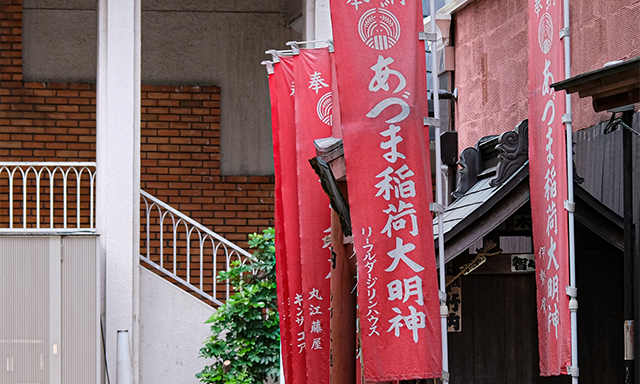
- Ogikubo
- I see. We often see flags with the dedicators’ name handwritten with marking pens, but it is not so here. Imagine the cost and effort that goes into each flag.
- Uino
- Yes. Each flag is quite a luxury. This district is home to many kimono stores, so it may be a feature unique to this area.
- Ogikubo
- I have heard that during the Haccho Jinja Meguri pilgrimage event, visitors can receive 5-yen (go-en) coins purified by the flamen of Hie Shrine.
- Uino
- That is truly “go-en” (fate) given from God. That reminds me – some advice for carrying good luck. Fate is determined by God, not offered by humans. Therefore, I never throw in a five-yen coin as an offering.
- Ogikubo
- I see. So which coin do you throw in?
- Uino
- Three-digit (“mi-keta”) coins, as a token of my appreciation for having found (“mitsuketa”) good luck (laughs)!
All List
- 2020.05.01 Visit Ginza’s Inari Shrines Vol.2 Asahi Inari Shrine
- 2020.08.01 Vol.3 Exploring Ginza in the Edo Period on an old map
- 2020.11.01 Visit Ginza’s Inari Shrines Vol. 4 Kakugo Inari Shrine
- 2021.02.01 Visit Ginza’s Inari Shrines Vol. 5 Azuma Inari
- 2021.05.01 Visit Ginza’s Inari Shrines Vol.6 Kabuki Inari
- 2021.08.01 Visit Ginza’s Inari Shrines Vol.7 Ginza Inari in Ginza 2-chome
- 2021.11.01 Visiting Ginza’s Shrines Vol. 8 Kumagai Inari Shrine
- 2022.02.01 Visit Ginza Shrines Vol. 9 Saiwai Inari Shrine
- 2022.05.01 Visit Ginza’s Shrine Vol. 10 Mimeguri Shrine and Shusse Jizoson on the roof of Mitsukoshi Department Store
- 2022.08.01 Visit Ginza’s Shrines Vol. 11 Komparu Inari
- 2022.11.01 Visit Ginza’s Inari Shrines Vol.12 Mankin Ryujin Seiko Inari Shrine
- 2023.02.01 Visit Ginza’s Shrines Vol.13 Hachikan Shrine
- 2023.05.01 Visit Ginza’s Inari Shrines Vol.14 Hoju Inari Shrine
- 2023.08.01 Visit Ginza’ Inari Shrines Vol. 15 Ryuko Fudo-son
- 2023.11.01 Visit Ginza’s Shrines Vol. 16 Hodo Inari Shrine
- 2024.02.01 Visit Ginza’s Shrines Vol. 17 Toyoiwa Inari Shrine
- 2024.05.01 Visit Ginza’s Inari Shrines Vol. 18 Yasuhira Shrine
- 2024.08.01 Visit Ginza’s Inari Shrines: Final Edition








